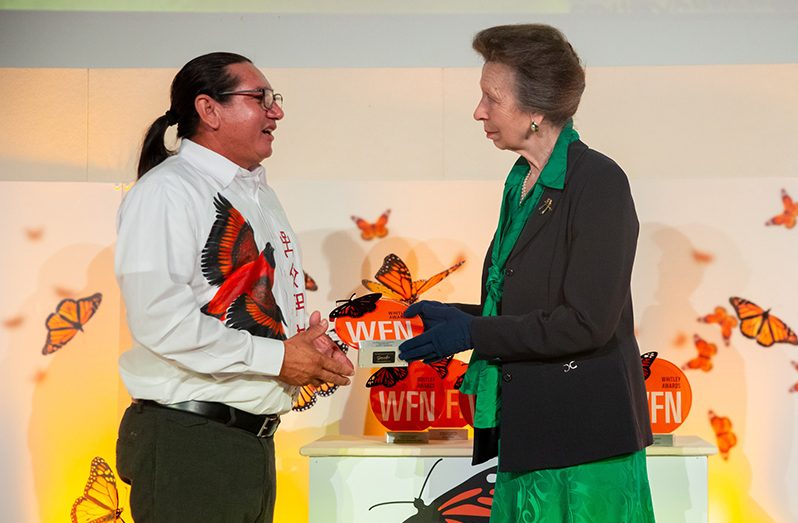-for helping to protect the Red Siskin
IN his quest to promote Guyana through the monitoring of the Red Siskin, for which they helped secure legal protection, Leroy Ignacio, an Indigenous Makushi, has been awarded a Whitley Award by the UK charity Whitley Fund for Nature (WFN) for his contributions to strengthening the protection of the small, endangered finch.
In a ceremony held at the Royal Geographical Society on May 1, HRH Princess Royal Anne delivered the Whitley Award. This represents 25 years since the Princess became involved as patron and 30 years since the inaugural Whitley Award was given.
The small, endangered finch has emerged as a flagship species for conservation in the nation’s rapidly developing rainforest and for sparking one of the first Indigenous-led conservation movements in the country.
Referencing the beauty of his region in a live YouTube stream of the event, Ignacio explained that “the Rupununi is a special place because of its natural beauty. Its dry woodland landscapes, rainforests, savannahs, and wetlands. I love it.”
Ignacio works in the expansive Rupununi region of Guyana, which has a special mix of habitats that contribute to their great diversity. Away from the coastlands, the region, which was once faced with increased threats of modernisation due to climate change, also contributed to habitat loss within the region. However, Mr. Ignacio said: “Habitat destruction mainly occurs through uncontrolled fires.”
Just over two decades ago, Leroy and his team were the primary agents for monitoring the Red Siskin, for which they helped secure legal protection. The Red Siskin was “scientifically” discovered in Guyana in 2000 by Leroy and a group of friends from local Indigenous communities, accompanied by international scientists.
Leroy asserts that while the Red Siskin’s existence was already known to the local people, its discovery was achieved “scientifically.” He noted that the bird has created a movement in conservation in the Rupununi.
Ignacio, who is the president and a founding member of the South Rupununi Conservation Society (SRCS), is organising a group of local rangers in southern Guyana to expand the community-managed conservation zone to encompass the whole habitat of the little songbird.
As a long-time supporter of the charity and WFN Ambassador, Sir David Attenborough stated that the expanding network of winners showcases some of the world’s top conservation leaders.
“Whitley Award winners combine knowing how to respond to crises, yet also bring communities and wider audiences with them,” he said.
In order to safeguard the bird, five Indigenous tribes collaborated to create the 75,000-hectare Red Siskin Community Managed Conservation Zone. They created one of the first zones of its sort in Guyana on their property, setting an example for other towns and drawing ecotourism to the isolated location.
With frequent flooding and droughts, Guyana is among the countries most susceptible to climate change worldwide. As per the World Bank, nine out of 10 individuals reside near the nation’s coastline, with some regions being two metres below sea level.
The Global South’s grassroots conservation leaders are aided by a UK nonprofit and the Whitley Fund for Nature (WFN). Through its channels, more than 200 conservationists in 80 countries have received £23 million over the past 30 years.




.jpg)








